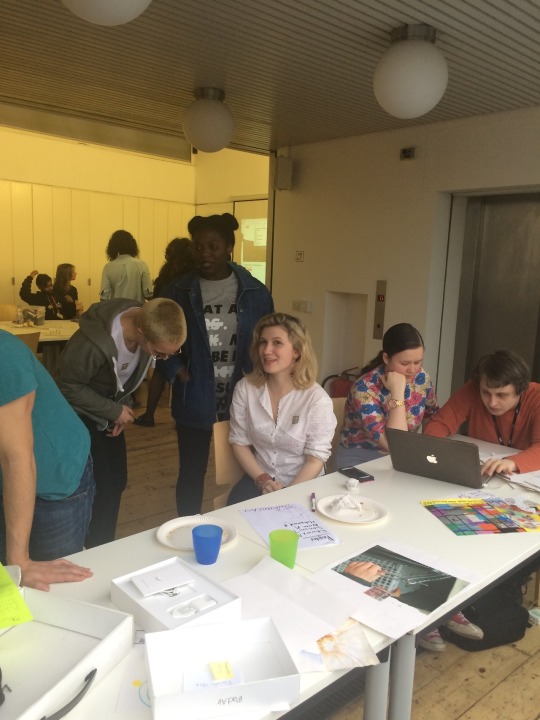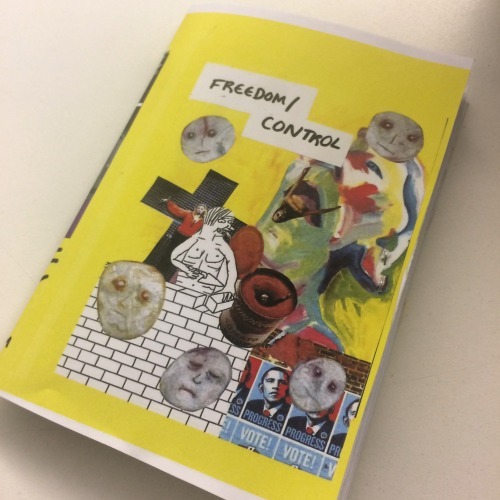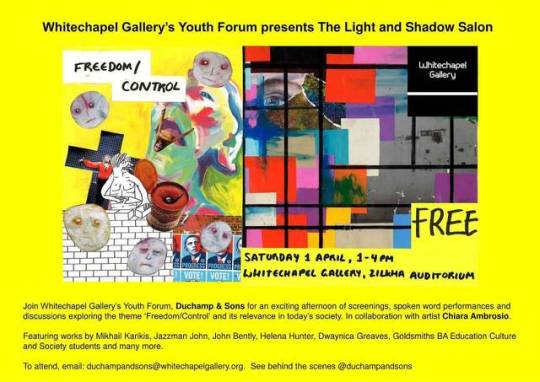Link
0 notes
Text
Wk 1: Introduction to the Light and Shadow Salon
We are still collaborating with the wonderful artist Chiara on this new project, but this time we are focusing on an entirely different aspect of her practice, concentrating on preparing for and curating our own event in Whitechapel Gallery’s auditorium, something which I personally have never done before and am excited to get right stuck into and learn more about!
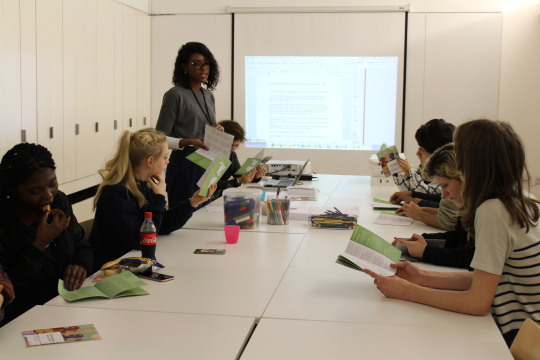
It was really interesting to get a glimpse into this entirely different side of Chiara’s work in our first session, and learning about the work she does at the Horse Hospital in the Light and Shadow Salon, “a place for artists, writers and audience to meet and share ideas about the past, present and future of the moving image in all its forms” left me totally intrigued, I wasn’t even aware that places and events like this existed before this session, and it is definitely something which I would love to get a little more involved in in the future!
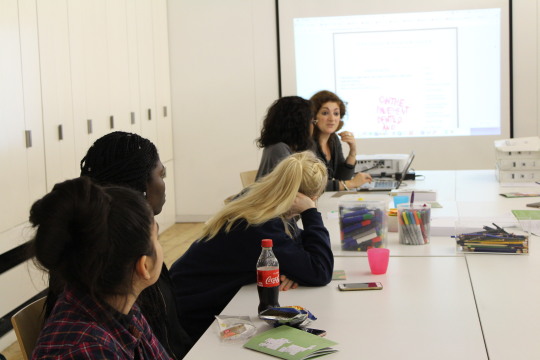
We watched some video clips of various events and pieces of performance art to get some inspiration, with a focus on different forms of activism and ways of getting powerful and important messages across to members of the public. We also had a chance to look at some zines that Chiara had brought along with her, and I was surprised to find that even the process of making these zines could be considered an aspect of curation, leading us on to begin thinking of ways in which we ourselves could physically record our event, to create something fixed and permanent that lasts and continues on long after the event itself has finished.
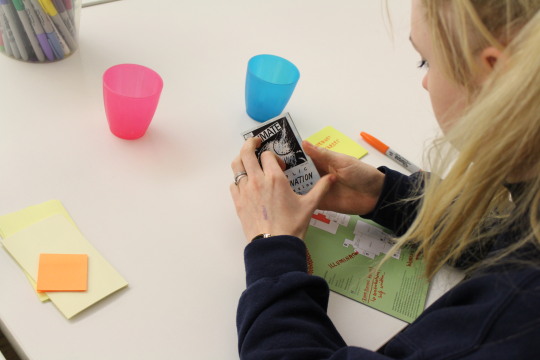
Post-it notes and pens in hand, we each made a few notes on personal ideas, which ranged from topics such as dystopia and identity, to the effects of the media on our health and even the magical properties of bread! At first I struggled to think of any ideas, but, inspired by the project I am currently doing in art at school titled ‘people and animals’, I began thinking about whether animals have souls, leading me on to brainstorm ideas of what happens when we die, as well as themes of religion, a sense of belonging and cult ideologies.


We were quick to discover a common thread that ran through most of our ideas, that being the theme of freedom and control: whether either/neither are good or necessary and whether they are really as different of ideas as we like to believe. Can you have freedom without control? Would either make us happy or be useful in creating a better society? All of these questions are particularly relevant in today’s political climate, which we could all agree we are all affected by and concerns and preoccupies us all to varying degrees.
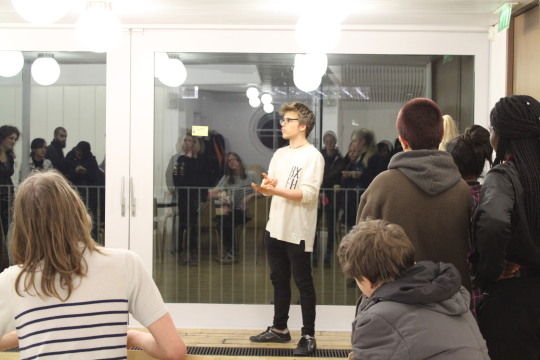
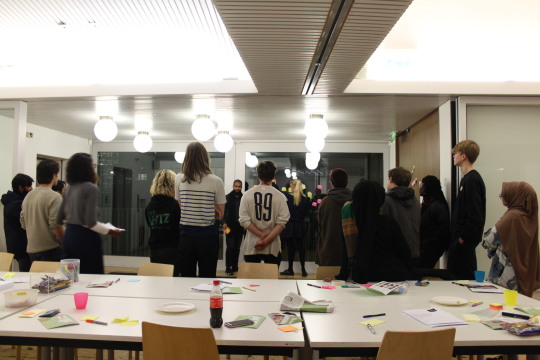
As the session came to a close, we were asked to start collecting materials related to the theme as well as think about any artists or filmmakers who we think would be relevant and would like to invite.

I am incredibly excited to see how this project unfolds as I am always amazed by what we manage to produce when collaborating as a group. It’s also so exciting that we have so much control over how the event takes place and who we would like to invite, and I hope that we manage to make full use of this freedom and create an event that we can all be proud of.
Hannah
0 notes
Text
Wk 2: Visit to the Bookartbookshop
For our second session we went to the Bookartbookshop, a very tiny book shop in Old Street which sells artists' books and independently published books. The shop has been running for almost 15 years and is THE place to find quirky, one of a kind books you won’t find in mainstream shops. “It is presently a not-for-profit organisation ploughing back any profits into the improvement of the enterprise, and while it aspires to have a team of full paid staff it is still dependent partly upon volunteer labour.” We came on a day when the bookshop wasn’t open to the public so we had the space all to ourselves, which was quite special.

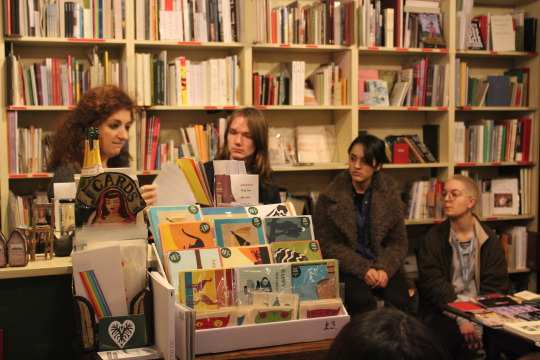
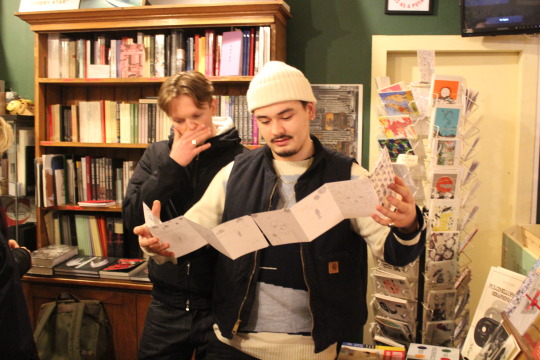
We considered books as spaces for curating; looked at how artists and writers use publications as mementos for events, to stage concerns and ideas, and the materiality of different publications. Chiara had laid out a selection of different publications to show us and talked through some of the works, she knew a lot stories about works and artists personally which made you have a different connection with the material.
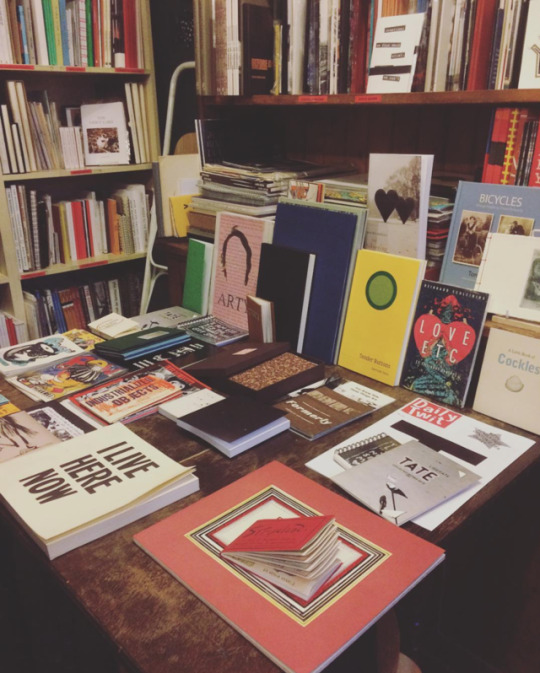
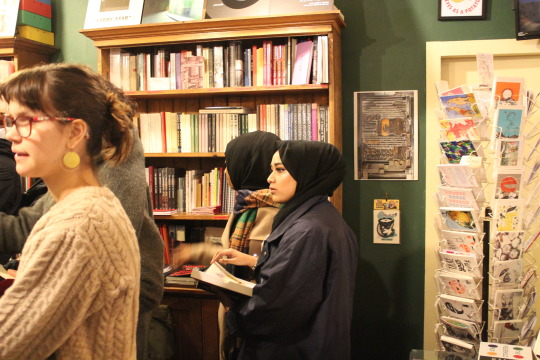
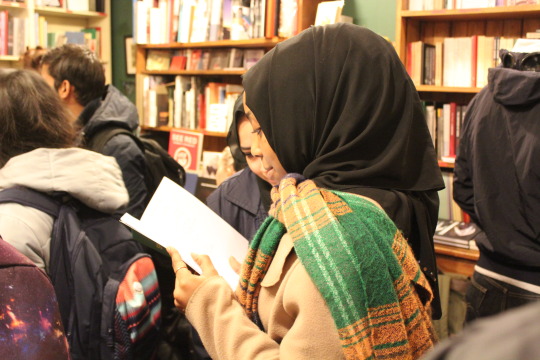
After the session we strolled to Pitfield Cafe, just a minute down the road, to a wonderful surprise- vegan carrot cake and pain au raisins! We reflected on what we’d seen at the book shop and discussed what we’d like to take forward for our event. It will be interesting to see how some of the publications and texts we saw today will influence our own publication.
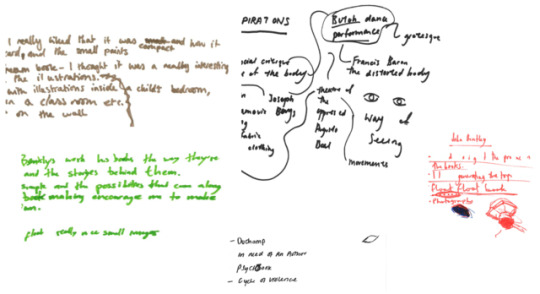
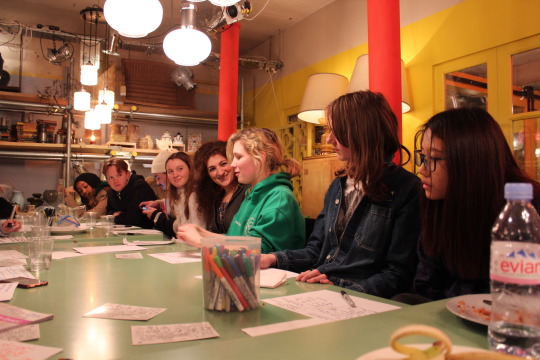
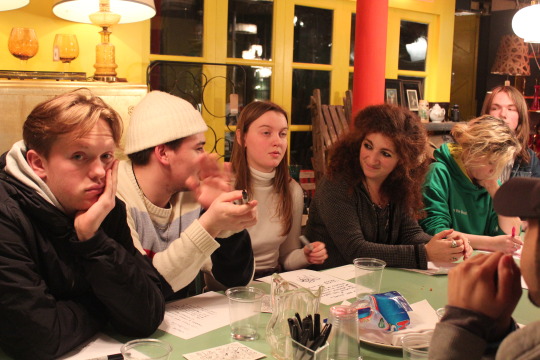
0 notes
Text
Wk 3: How to curate an event
So we’re getting down to the nitty gritty! We started this session by visiting the Zilkha Auditorium where our Light and Shadow Salon will be held. There was a buzz in the air as it dawned on us that we get to have this space for a day, a space where hundreds, if not thousands, of great artists have shown their works, knowing this fact makes our event feel so special and important.
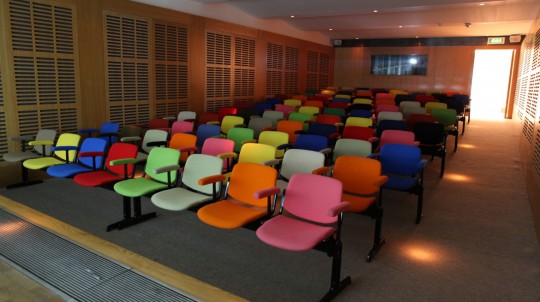
We all tried to get a feel for the space, we got up on stage, sat in the seats and looked through the glass window into the projection room where the audio visuals are controlled from. It was exciting to know that we would also get a chance to use the technical equipment in the projection room. We then left the auditorium to head up to the Creative Studio.

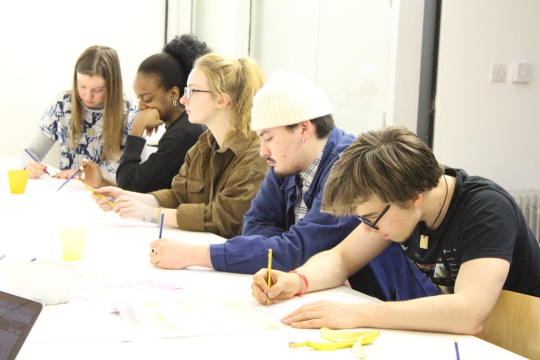
As a group we considered the roles, functions and tasks involved in the curation and programming of events: curation, editorial, design and advertisement and Q & A moderators. These are the roles we would need in planning. We also looked at the roles we would need on the day, such as production/stage manager, technician, host and person on the door. The back of house is just as important at the front of house, all hands on deck to steer the ship.
With the roles, mentioned above, chosen we then divided into three sub-groups to research artists and view their works on the internet, we discussed works we would like to include on our chosen theme, Freedom/ Control.
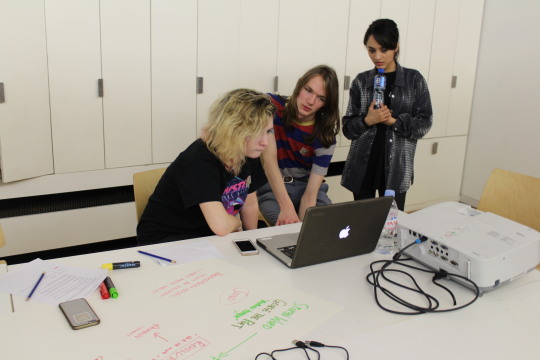

Initially we seemed to focus on artists working with film, but then quickly branched out to think of spoken word performers, live performances and even photography.
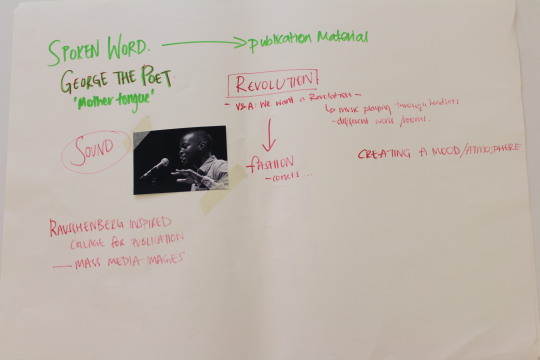
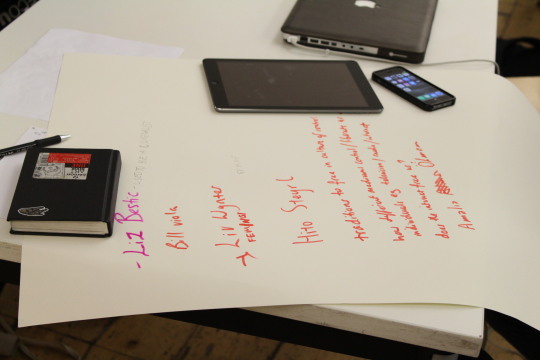

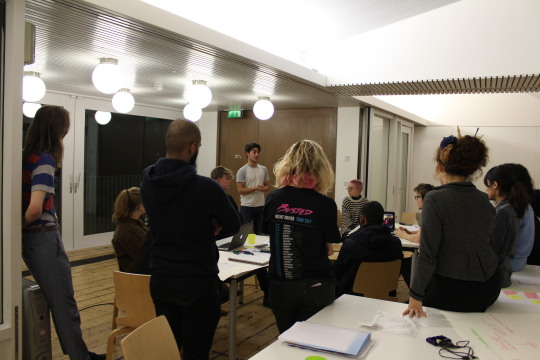

Each group then presented the artists they thought would be great to involve in our event with everyone else. It was a diverse mix of people and ideas.
Here are some of the names we all came up with:
Bob and Roberta Smith
Hito Steyerl
Tom Hunter
Bill Viola
George the Poet
Liv Wynter
With the session winding down we had made a great start, we had so much still to do though, but the atmosphere in the room was one of excitement. It felt more of a reality that we’re actually putting on this event at Whitechapel Gallery for the public to come to, such an amazing prospect!
0 notes
Text
Wk 3: The Light and Shadow Salon @ The Horse Hospital
Following yesterday’s session we visited The Light and Shadow Salon curated by Chiara at The Horse Hospital. This underground space is imbibed with lots of history and actually used to be a horse hospital. “The Horse Hospital is London’s longest running, truly independent arts venue creating an alternative, celebrating irreverence, individualism, anti-conformism, sincerity and integrity. Championing the outsider, the unfashionable, the other.”
LIGHT AND SHADOW SALON PRESENTS 100 BOOKS: A VIGIL was a marathon reading of John Bently’s one hundred poems, read by one hundred people, some who were artists and performers, and some for whom this was their first experience reading a poem to an audience.
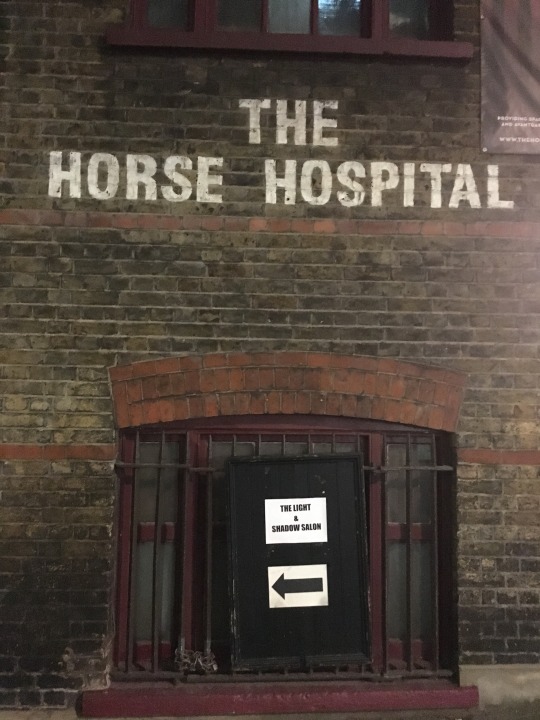

Here is the project in John’s words:
“I made this book, “Liver & Lights No 23: 100 books” in the mid 1990’s as a personal response to various then recent acts of state tyranny against writers and other people who had criticised a government in some way…The Nigerian Ken Saro Wiwa had just been executed, among others. The project started life as a 100 word poem made in a 100 versions, with each version changed by one word, but somehow still retaining its meaning. I set the poems in 100 different hand made books. I felt this somehow reflected my feeling that you can kill the singers but never the song, once sung”.
Each reader was given a number and their poem upon arrival and were asked to mark the page some how. Seven of us participated.
Iarla: I read number forty-nine. It was magical to have one hundred people all using poetry to call out for an end to war, tyrants and violence across the world. To be part of a ritual so pertinent at this time was truly a life-affirming experience. In a world that can feel full of callousness and violence, this was a ritual of togetherness and hope.
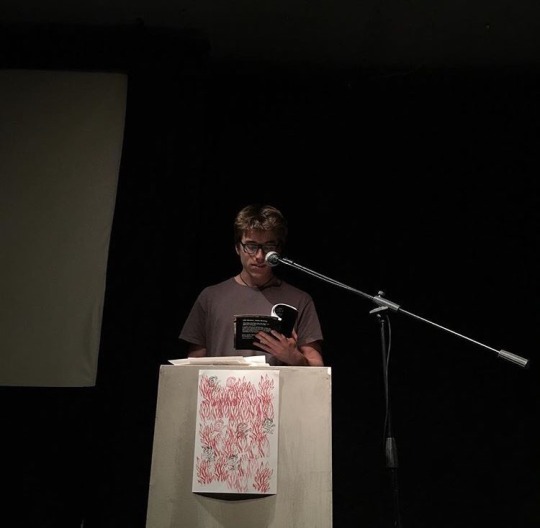


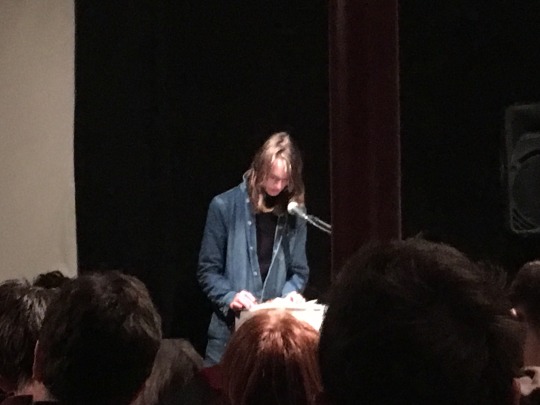
Hafsah: Reading an amazing poem to such a mature audience was quite nerve-wracking but as soon as I read the last word, I wanted to do it all over again. Watching the other members perform with such creativity kept me inspired and entertained.
Renee: To be honest, I didn’t quite absorb the experience until the next morning. I didn’t participate in the readings so my experience of the night was in a way different to yours. For me, it was a test of endurance and a reminder that the call to resistance isn’t always pleasurable, that sometimes we have to give more than we initially want to see change become a reality.
Sammara: I love poetry, but for some reason had always thought reciting poetry takes something away from the words. This changed my mind, completely. Not only was it exciting but I found that reading/reciting the poems out loud made John Bently’s words even more valiant and created a unifying force among the audience/readers that could be felt in the room.


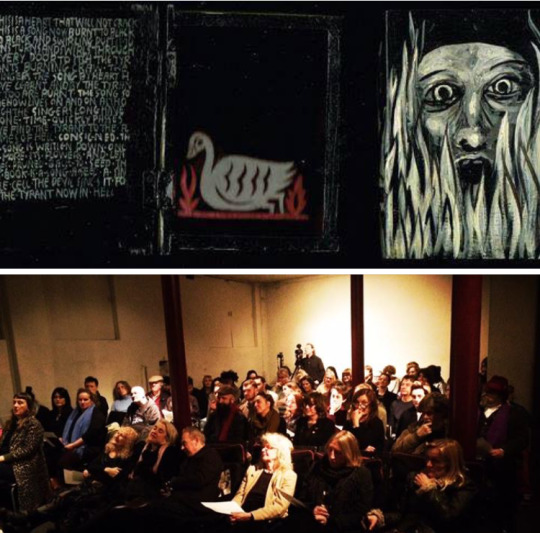
Hannah, Akraam and Mo met John Bently at the end who gave them free copies of his 100 books and signed them too!
0 notes
Text
Wk 4: Researching artists, creating invites, designing a publication
Two weeks later we’re back in the Creative Studio creating content for our event. We divided ourselves into three main groups- Curatorial, Design and Invitation, and Publication teams. With an hour and a half left, we dove straight in.
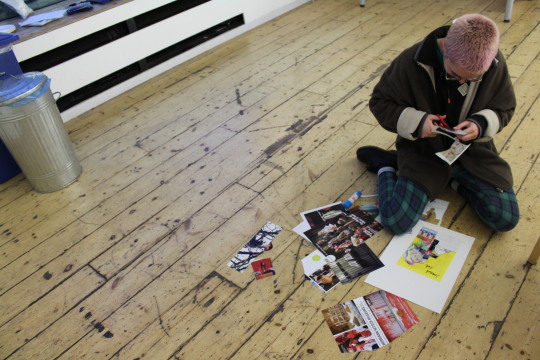
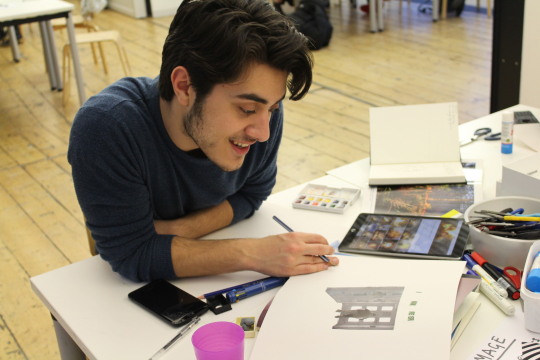
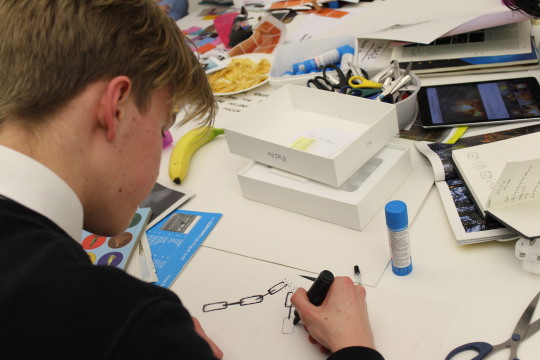


The Design team hard at work creating an image for the event. They will also have to think of the invitation text but one thing at a time.

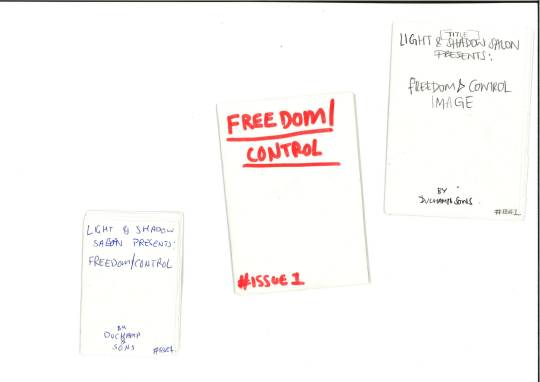
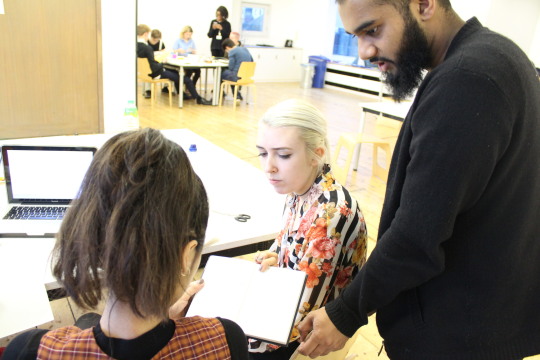
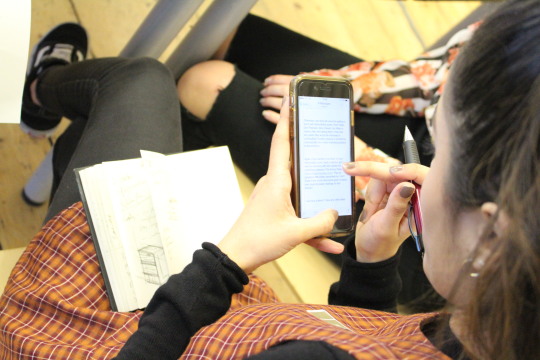
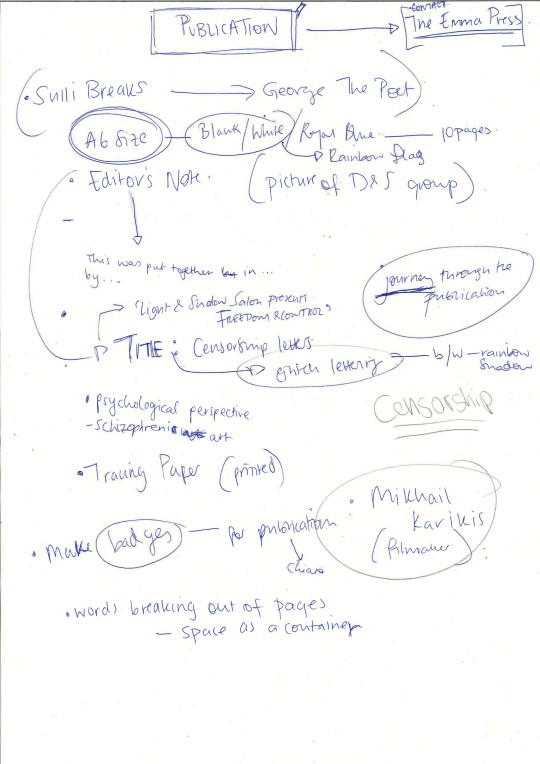
Publication team using every technology available to find and create content. Currently we’re thinking of including an interview with one or two artists, a poem (thanks Dwaynica!), images, and a blurb on the project. Also having to think of the design, shape and form of the publication- how many pages, what type of folds etc.
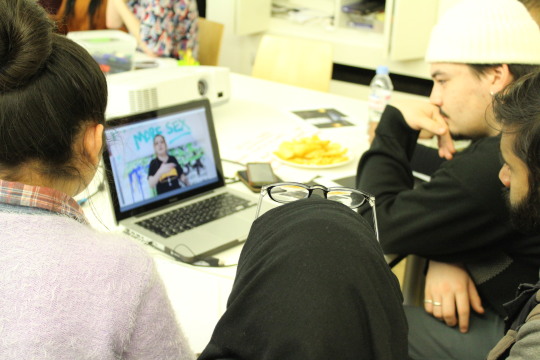
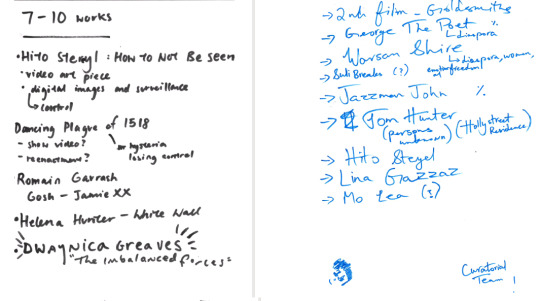
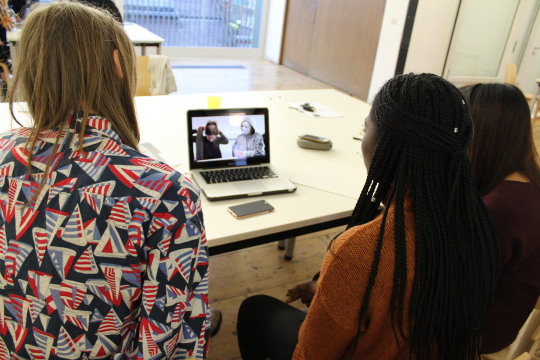
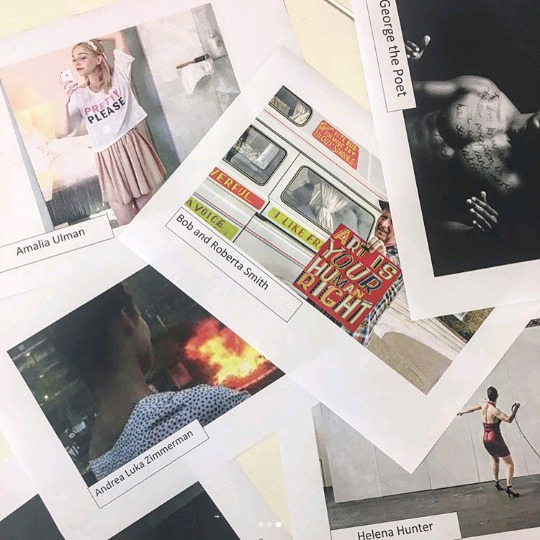
Curatorial team intensely looking up, watching and discussing artists’ works.
Getting to the end of the session we gathered round to see what each team had worked on. It took a while to decide on the final image so we left and returned later to make the decision. That was probably the most definite outcome of the session.
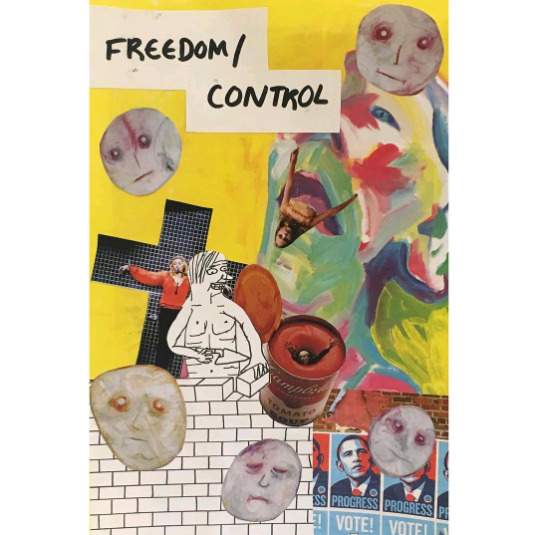
0 notes
Text
Wk 5: Artist talk with Mikhail Karikis
Last week the artist Mikhail Karikis talked to us about his work particularly, his recent project Aint Got No Fear, made in 2016 with 11-13 year old boys rapping about their lives. I found the film he created really interesting and inspiring as it expressed an amazing and insightful view of the life of the children in the Isle of Grain in South East England. You can find out more about this fascinating project here.
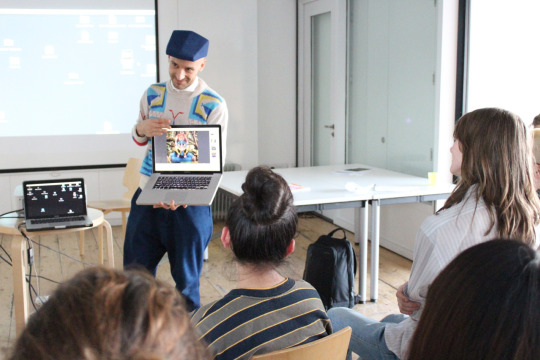
Here’s a transcript of our discussion with him:
Mikhail Karikis: Renee mentioned the word socially engaged project, do you know what that might be?
Sammara: Is it that you work with the different boys in the film? I read that on your website.
MK: Thank you for being honest.
[Laughter]
MK: Yeah but as a practice in general- socially engaged art practice- what do you think might be?
Hafsah: Involving the public?
MK: In principle, this is what it means. Then how would you engage the public and why would you engage the public? So maybe in the last decade or so, I’ve created works that belong to this genre which for me means that I don’t work in the studio, like a lot of painters or directors, they would know their plan in advance of what they’re going to make and then go and shoot. Usually my work is site- specific, meaning that I’m always developing my projects in specific locations with people who inhabit these locations, people living there or working there and usually through my work I’m trying to understand what their lives are like, how they make a living, what relationships they have and then we develop a project together. So it’s not as if I’m kind of going there, picking up a camera and filming them and then go away, I mean some people might call this socially engaged but actually where is the engagement? I usually develop relationships when I make these projects and it takes usually quite a lot of time and then negotiate with the people that I collaborate with on what it is to make.
0 notes
Video
instagram
After watching Aint Got No Fear, we had a Q&A session with Mikhail.
Josh: How are the kids to work with? They looked a little rowdy, like the way they’re going like this [signals]? [laughter]
MK: Oh no, they’re totally performing that.
Josh: Okay so they’re not like that normally?
MK: They’re not, I don’t tell them how to perform. I think what is interesting is that they’re at this in between age – between being men and being children, like one moment they’re being children and the next they want to be gangstas and I think there’s this kind of inconsistency which I quite like, because of that age being 14 years old and the kind of models of masculinity they have or aspire to, they come from videos where they see rappers doing this or that [signals] but they’re totally over-performing it for each other. The thing is I never tell people what to do, so with young people I’m usually on good terms with them because I don’t think my role is to tell them what to do, on the contrary they should tell me what to do. I think it’s nice, sometimes they were rowdy but I quite like it.
Sammara: Did you come into contact with any of their parents since you showed some projects in the village?
MK: I came in contact with them and of course the parents were invited to all of this but a lot of the kids only have one parent or if they have two they work a lot which means they’re absent quite a lot so it wasn’t so straightforward to meet the parents. But of course we needed permission from the parents to work with the children so when the children knew they were interested in taking part in the project we gave them a form and said can you show this to your parents and ask them to sign it? The thing is we received the forms back signed but I don’t know who actually signed them, could have been them… I don’t know. There were a couple of parents who came to Whitstable Biennale to see the film. We organised a coach to bring them, that day was very nice because parents, grandparents, very young children– their younger brothers came, so there was like three generations which was very nice but there hasn’t been a follow up although I’ve tried many things but I understand it’s not easy and expensive to follow the life of the video.
Tsw Wai: So you’re an artist who does socially engaged projects, so art is no longer an individual thing but a collective experience, so how does this translate to your own personal vision as an artist?
MK: That’s a very good question because that is also my personal vision. I sometimes think wherever I go there’s a kind of ship and I try to kind of steer it, not telling people what to do but somehow whoever’s interested in coming on board, developing a project with them. I create, I suppose a conversation with people, you know this communal vision. There is always a kind of material focus, I’m very interested in sound and the voice so that‘s a consistent aesthetic development that you see from one project to the next. Yeah, I mean I don’t know how else to answer this question. My individual vision, I guess when I do these projects is not different from what it is that we create together, it’s part of it.
Chiara: Do you think of the way your work practically transforms the space and the lives of the people you work with, the process but also or the legacy or if it has the power to transform?
MK: Well, I always think about this because I have to leave and that’s the thing. These children are not in my neighbourhood, they’re somewhere else, and I’m lucky that most of my projects are Britain so I always think what the legacy of the project is. The answer is not really straightforward I think. When I work with older people for me, it’s always easier. Working with this group and a project in 2013 with younger kids aged between 5 and 11 in Italy, I become similarly attached and especially with this it was very painful. Actually, on my way back on the train I’d cry because it was just impossible! How can I leave when they wanted me to stay longer and do things with them and I was really thinking what can an art project do? They live in a kind of difficult place but then they will give me feedback, unsolicited feedback which remains. A boy wrote to me saying ‘oh yeah, I’ve been feeling very blue all week except for when you’re here and I can’t wait for you to come back to the project, I really enjoyed it’. Just things like that are amazing. This project is very important to me but actually it’s very important to them, it really means a lot to them to make something and I think what else comes across is how it might change their visions of themselves in the future.
So, at some point I give them cameras and one of the boys, he’s a very talented photographer naturally and I told him ‘you’re super talented and have amazing potential’, I think he’s not used to receiving a lot of compliments so he didn’t say anything. Then later on they’d ask me where I’ve been to during the week because sometimes I have a crazy schedule and I’m in three countries in three days, and Eddie (the boy) said ‘oh my God I would love that travelling to places’ and at that point I told him ‘you’re a very talented photographer, how about thinking of becoming a photo journalist?’, and we just left us with that. A month later I was talking to his mum she told me ‘this project is quite important to Eddie I think because one, he is very excited about it. You know his dad’s a lorry driver, he doesn’t know anything else, and the other day he came up with the idea of becoming a photojournalist! [Laughter]
I think it kind of made them realise that there are other possibilities, other ways of thinking about themselves in the future which is something positive I think.
Valentina: How often do you keep in touch with them?
MK: Now? Depends. Usually when there is an event connects the project I messaged them on Facebook. Sometimes they’re really amazed that I put something on Facebook and there’s like 200 people responding to it and they’re like ‘Oh my God’ and they’re really proud.
Renee: I had a question about the boys drumming on the police helmets, you said you were going to tell us a story about that?
MK: Yeah, I don’t know if people got it because, it was quite a short sequence. It came out of both humour and being angry.
R: Yeah, a kind of protest but in a kind of jokey way.
MK: Yeah, it’s a kind of jokey reversal of roles because usually you see police helmets hitting civilians and this was a kind of a reversal of that, they’re making music and noise out of it. So there’s another one which most people don’t really see but it’s totally fine, at the end of that sequence there’s an image of an inflatable pig on the ground which some people got when we showed it. It was a combination of two things, one of them was a girl told me ‘I’m going to be in your video only as long as I dress as a pig’, so I said ‘okay I’ll bring a pig’- also because she loves pink- and then you can be in my film. But on the day we were shooting that she wasn’t around, she didn’t turn up so the boys said ‘yeah but the police are pigs’. I guess there were quite a lot of parents who thought what did you use our children for? [Laughter] But I think it’s subtle enough that it’s not offensive unless a police man watches it in which case if they’re offended I would love that!
Sammara: Do you think this particular film made any political changes in the area, like an enrichment centre for young people?
MK: I very much doubt that. That connects with some of my despair when I was working there and even thinking that that place is so infrastructurally neglected by the government; this is not a job for an artist, this is a job for politicians and the local councillor to address these issues. I don’t have the skills nor the resources to bring change what it’s doing is bringing light to an issue for people to discuss and be aware of. The film been seen by thousands of people not just here but internationally so we generate debate but I think the most important thing is that it actually has brought about some change in relation to the kids and how they feel about themselves and their confidence. I think at the beginning of the project they probably thought was impossible for them to make a film, I mean how do you even begin to make a film or write a song? For me that is my important.
There are artists/activists whose work specifically targets politicians and highlights I suppose in a confrontational way political issues but I don’t think I have that in me. I have very strong opinions about politics but usually my character is a bit gentler, in a more humanist way, thinking about how can I work with people to do something that is interesting for them and bring something to them. It’s kind of more emotional and psychological the kind of change my projects bring rather than large-scale political. I wish I had the skills but I don’t think I have. I’m outspoken but I don’t have the calm; I think if I was having a debate with a politician I would probably freak out, I think I probably lose it. [Laughter] I’m not able to keep myself together. You know what I mean, when you’re upset and you’re kind of losing the plot and you don’t know what to say.
Hafsah: I noticed how you felt quite passionate about the interview, being controlled by the police and the raves being shut down. How can you relate to them, have you had an experience yourself that you feel like you’re being controlled by someone who is in authority?
MK: Oh my God, all the time! [Laughter]
School was terrible, I mean my school was absolutely terrible in terms of being controlled and also hit by my teachers.
Josh: What, you were hit?
MK: Hit, of course I’m slightly older than you, I was hit by my teachers.
Josh: With a cane as well?
MK: Cane as well. I’ve been slapped which is so common, so humiliating for someone obviously bigger than you, more powerful than you to hit you! You know they’re going to win anyway and I knew I was going to lose anyway so what’s the point? It was not an equal battle but I mean I do feel angry every time my ticket is controlled. From home to Saint Pancras station I have been photographed by I don’t know how many hundreds of cameras then I have to go to the ticket barriers, then get on the train and within five minutes there’s someone searching my ticket because I’m suspect, I mean everybody is a suspect, everybody is a potential thief, everybody has potentially cheated! I mean to think about it there’s so much distrust that you think that I’ve been able to evade all this surveillance and the ticket control and the controller on the train, I just think that this is a culture of suspicion which I absolutely despise and it makes me very angry, well this amongst other things. [Laughter]
And I guess there is one more point, the older generation. I feel very controlled by the political class that is slightly older taking decisions that don’t represent me and I know don’t represent your generation. Like what happen with Brexit referendum, I think the older generation who will not be so much affected by it. All of us actually have said the people that are going to have to live with the consequences more than us are the generation that are just coming after us. Let’s have some sort of consultations in school and get some indication into what young people are thinking, people who don’t have a political voice yet because they’re 16 or 15, let’s ask them to have the some sort of political debate about this and maybe each school to give some kind of result, an indication throughout the country as to how this younger generation thinks about this issue, that could have been taken into account but you see the older generation that have the power didn’t care about this which I think is horrendous. It doesn’t matter what side it was even if the results were pro Brexit I think we should have asked younger generation so I’m angry about that too!
Akraam: Were you at the Lulu dress rehearsal (ENO)?
MK: Oh right, yes I was.
Akraam and Mo: Yeah, we remember you, you were sitting in front of us and you were wearing this same hat.
MK: Really, I think it was similar.
Renee: And you had on a big coat.
MK: Oh yes, I remember now, it was the light blue woolly coat.
Josh: Where did you get your hat from and your clothes?
MK: It’s from a place in Covent Garden called United Nude.
Josh: I’m googling it now?
D&S: And when you were working with the young people do you wear these clothes?
MK: No, I tone it down.
Thanks Mikhail!
After meeting Mikhail, the Invitation & Design team worked on the final idea for the poster for publicizing the event and the message to accompany it. It was challenging to come to a decision for an image upon which we all agreed but we finally went with a combination of two images that each represented freedom and control. I’m really excited about the event, as I think the group have worked together to create a great collaborative work and I can’t wait to see how the afternoon turns out.
Jemima
0 notes
Text
Wk 6: Final prep
This session started with a quick catch up on what we’d need to do. The air was filled with excitement mixed with nervousness and tension which was expected, in a way kept us on our toes. The Curatorial team worked together to finalise programme which involved lots of discussion and watching all the material again. There were more films to show than time available so we needed to decide which fitted well with the theme, how the works responded to each other and ways to juxtapose them to create a story or generate a discussion with the audience.
0 notes
Text
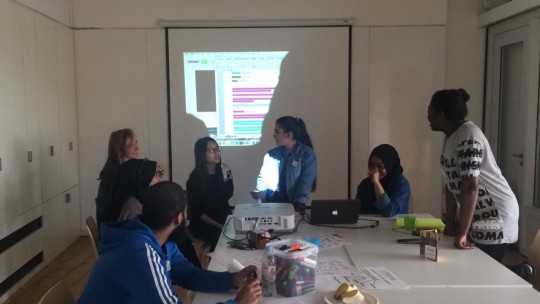
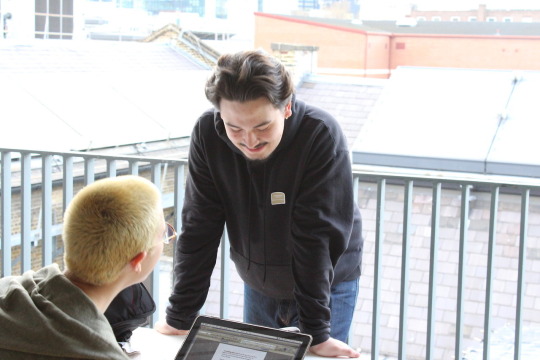
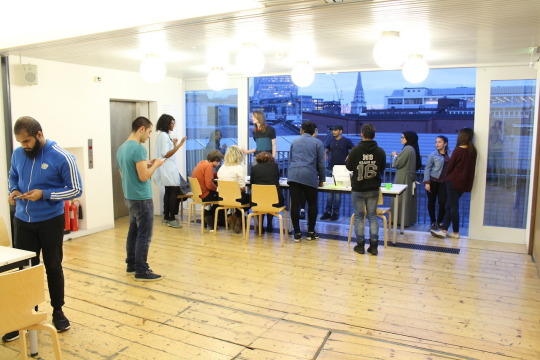
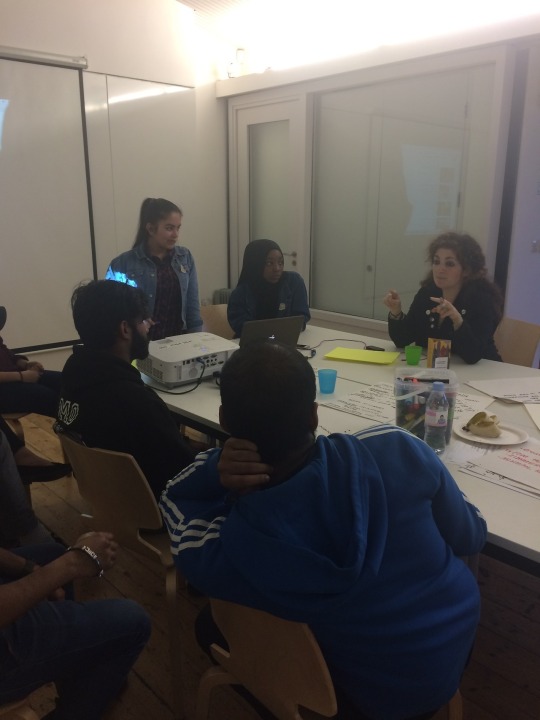
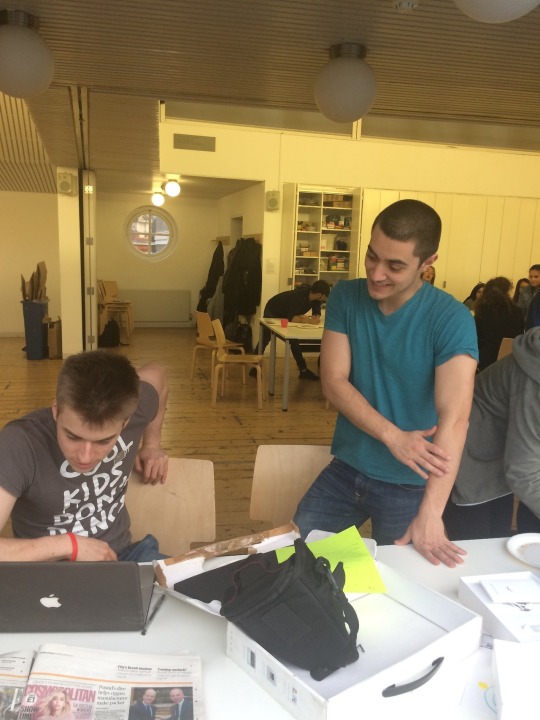
We learnt artist Helena Hunter couldn’t join us so instead she wrote a piece to be read before the screening of her film ‘White Wall’. However we’re excited that jazz lyricist, Jazzman John has accepted our invitation to perform and has written a piece in response to our theme ‘Freedom/Control’.
Josh and Dan, the hosts for the event spent the evening developing a welcome, rehearsing their jokes (eye roll) and writing an introduction for the zine.
The publications team had a lot to do but surprisingly we managed to pull it off with the help of the Design team. Chiara showed them how to set up a framework on Photoshop so they could just drop the content in. After lots of editing it came together. Everyone burst in cheers and applause when the first copy was revealed!
0 notes
Link
How beautiful! We didn’t have time to print and assemble copies so we’ll have to do this on the day. This was a long session but totally worth it!
0 notes
Text
The Light and Shadow Salon
On Saturday 1st April we held The Light and Shadow Salon in Whitechapel Gallery’s auditorium! The day began with a human assembly line making publications for the event (check us out below). Naturally, we were nervous as this was the first time we’d used the auditorium, we were also unsure of how many people would turn up.
Calvin, one of the gallery’s AV technician showed us how to mic up speakers and gave us a quick behind the scenes tour of the AV booth where he’ll be screening the films and running the technical aspects of the day. We also had to test the equipment to make sure everything was working.
After some pizza and lots of rehearsals we were ready.
0 notes
Link
0 notes
Text
With about 10-15 minutes to start we went into the exhibition spaces and outside the gallery to invite people and hand out flyers.
The day was divided into three sections and started with a funny and engaging intro by Josh and Dan. Take a look at the programme.
0 notes
Photo
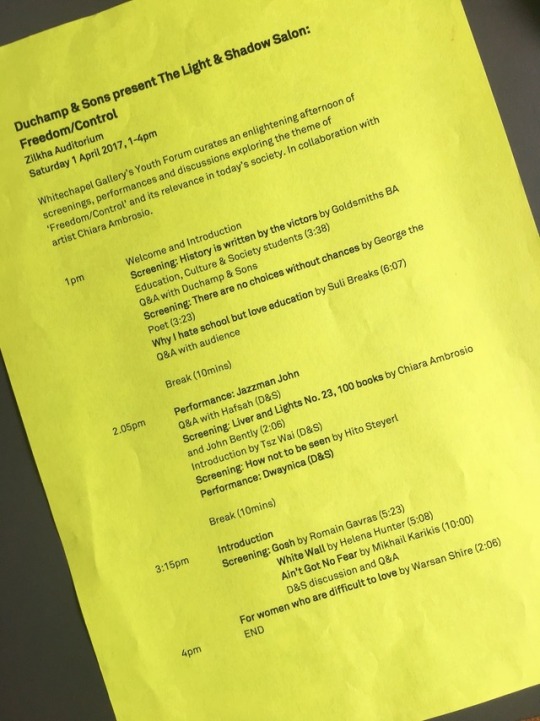
The first section generated quite sensitive discussions which led us to comment on why we’d chosen to show the three films together.
0 notes

